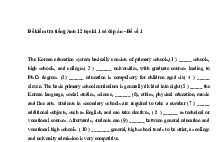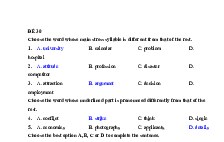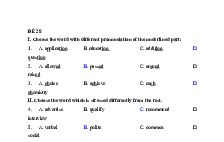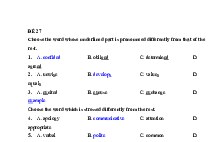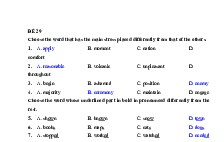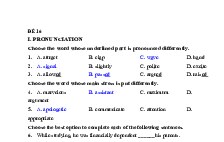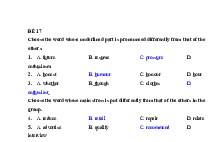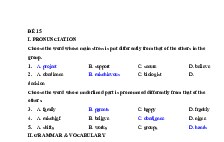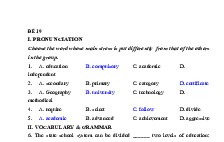Đề thi thử TNTHPT môn Tiếng Anh
Nội dung tài liệu
Tải xuốngCác tài liệu liên quan
-
![Đề thi học kì 1 Tiếng anh lớp 12 năm 2020-2021 ĐỀ SỐ 2]()
-
![Đề thi học kì 1 Tiếng anh lớp 12 năm 2020-2021 ĐỀ SỐ 1]()
-
![Đề thi học kì 1 Tiếng anh lớp 12 năm 2020-2021 ĐỀ SỐ 30]()
-
![Đề thi học kì 1 Tiếng anh lớp 12 năm 2020-2021 ĐỀ SỐ 28]()
-
![Đề thi học kì 1 Tiếng anh lớp 12 năm 2020-2021 ĐỀ SỐ 27]()
-
![Đề thi học kì 1 Tiếng anh lớp 12 năm 2020-2021 ĐỀ SỐ 29]()
-
![Đề thi học kì 1 Tiếng anh lớp 12 năm 2020-2021 ĐỀ SỐ 16]()
-
![Đề thi học kì 1 Tiếng anh lớp 12 năm 2020-2021 ĐỀ SỐ 17]()
-
![Đề thi học kì 1 Tiếng anh lớp 12 năm 2020-2021 ĐỀ SỐ 15]()
-
![Đề thi học kì 1 Tiếng anh lớp 12 năm 2020-2021 ĐỀ SỐ 14]()
Có thể bạn quan tâm
Thông tin tài liệu
GV. ĐỖ MINH TRUNG ĐỀ THI THỬ SỐ 2 |
ĐỀ THI THỬ THPT QUỐC GIA MÔN. TIẾNG ANH Thời gian làm bài. 60 phút; không kể thời gian phát đề |
|---|
Mark the letter A, B, C or D on your answer sheet to indicate the word(s) CLOSEST in meaning to the underlined word(s) in each of the following questions.
Question 1: I strongly recommend that you should take out an insurance policy in the house for your own peace of mind.
A. to stop your believing B. to stop your thinking
C. to stop your worrying D. to stop your sleeping
Question 2: I'm sorry I can't go to the movies with you this weekend - I'm up to my ears in work.
A. very idle B. very busy C. very scared D. very bored
Read the following passage and mark the letter A, B, C or D on your answer sheet to indicate the correct word for each of the blanks.
Interpreting the feelings of other people is not always easy, as we all know, and we (3) ______ as much on what they seem to be telling is, as on the actual words they say. Facial expression and tone of voice we obvious ways of showing our (4) ______ to something, and it may well be that we unconsciously express view that we are trying to hide. The art of being tactful lies in picking up these signals, realizing what the other person is trying to my, and acting so that they are not embarrassed in any way. For example, we may understand that they are in fact (5) _______ to answer our question, and so we stop pressing them. Body movements, in general, may also indicate feelings, and interviewers often pay particular attention to the way a candidate for a job walks into the room and its down. However, it is not difficult to present the right kind of appearance, while (6) ______ many employers want to know relates to the candidate's character traits, and psychological stability. This raises the awkward question of whether job candidates should be asked to complete psychological tests, and the further problem of whether such tests actually produce reliable results. For many people, being asked to take part in such a test would be an objectionable intrusion (7) _____ their private lives.
Question 3: A. reckon B. estimate C. rely D. trust
Question 4: A. feeling B. view C. reaction D. notion
Question 5: A. humble B. used C. arrogant D. reluctant
Question 6: A. which B. that C. what D. this
Question 7: A. in B. into C. about D. with
Mark the letter A, B, C, or D on your answer sheet to indicate the word(s) OPPOSITE in meaning to the underlined word(s) in each of the following questions.
Question 8: About 95 percent of all animals are invertebrates which can live anywhere, but most, like the starfish and crabs, live in the ocean.
A. with backbones B. with ribs C. without ribs D. without backbones
Question 9: If you say bad things about the person who give a job you bite the hand that feeds you.
A. be unfriendly B. be ungrateful C. be thankful D. be devoted
Mark the letter A, B, C or D on your answer sheet to indicate the correct answer to each of the following questions.
Question 10: Why does he need to make such heavy _____ of a simple task?
A. climate B. torm C. weather D. cloud
Question 11: I am considering _____ my job. Can you recommend a good company?
A. changing B. to move C. to change D. moving
Question 12: The more you practice speaking in public,______.
A. the more confident you become B. the more you become confidently
C. he greater confidence you become D. the more you become confident
Question 13:
Peter: "Have you ever been to a live concert?"
Mary: "No, I haven't. But I'd very much like to, _____.
A. though B. although C. yet D. moreover
Question 14: _____ as the representative at the conference, she felt extremely proud of herself.
A. Be chosen B. Having been chosen C. on choosing D. Having chosen
Question 15: No one on the plane was alive in the accident last night, _____?
A. wasn't he B. weren't they C. were they D. was he
Question 16: Monica was so angry about the noise her neighbors were making that she refused to _____ it anymore.
A. get away with B. put up with C. run away with D. cut down on
Question 17: My neighbour is _____ photographer: Let's ask him for _____ advice about color film.
A. a - the B. the - an C. a – x (no article) D. the - the
Question 18: Her fiancé is said _____ from Harvard University five years ago.
A. to have graduated B. to be graduated C. being graduated D. having graduated
Question 19: I don't know what it _____ to be as popular with girls as my brother is
A. uses B. takes C. demands D. expects
Question 20: I was most _____ of his efforts to help me during the crisis.
A. appreciate B. appreciable C. appreciation D. appreciative
Question 21: My brother asked me _____ of the football match.
A. what do you think B. what I think C. what did I think D. what I thought
Question 22: Amber is a hard, yellowish brown __from the resin of pine - trees that lived millions of years ago.
A. substance formed B. forming a substance
C. substance has formed D. to form a substance
Question 23: If people paid a little more attention to the environment, the Earth _____ greener.
A. would be B. will be C. wwould have been D. had been
Question 24: The goal is to make higher education available to everyone who is will and capable
his financial situation.
A. regardless of B. owing to C. in terms of D. with reference to Question 25: Timmy dropped the on doing this task again because of his carelessness. I can't stand him anymore.
A. pin B. needle C. bottom D. ball
Mark the letter A, B, C or D on your answer sheet to indicate the word that differs from the rest in the position of the main stress in each of the following questions from 31 to 32.
Question 26: A. effort B. actor C. perform D. area
Question 27: A. disappear B. recommend C. entertain D. fortunate
Mark the letter A, B, C, or D on your answer sheet to indicate the sentence that best combines each pair of sentences in the following questions.
Question 28: Jenifer rejected the job offer. She now regrets it.
A. Jenifer regrets not having rejected the job offer.
B. If only Jenifer didn’t reject the job offer.
C. Jenifer wishes she hadn’t rejected the job offer.
D. Jenifer regrets to reject the job offer.
Question 29: The master of ceremonies has a very soft voice. Everyone listens to her attentively whenever she appears on the stage.
A. So soft is the voice of the master of ceremonies that everyone listens to her attentively whenever she appears on the stage.
B. As long as the master of ceremonies hadn’t had a very soft voice, everyone wouldn’t listen to her attentively whenever she appears on the stage.
C. Only after everyone listens to the master of ceremonies attentively whenever she appears on the stage does she have a very soft voice.
D. But for a very soft voice, everyone would listen to her attentively whenever she appears on the stage.
Read the following passage and mark the letter A, B, C or D on your answer sheet to indicate the correct answer to each of the questions.
Many flowering plants woo insect pollinators and gently direct them to their most fertile blossoms by changing the color of individual flowers from day to day. Through color cues, the plant signals to the insect that it would be better off visiting one flower on its bush than another. The particular hue tells the pollinator that the flower is full of far more pollen than are neighboring blooms. That nectar-rich flower also happens to be fertile and ready to disperse its pollen or to receive pollen the insect has picked up from another flower. Plants do not have to spend precious resources maintaining reservoirs of nectar in all their flowers. Thus, the color-coded communication system benefits both plants and insects.
For example, on the lantana, a flower starts out on the first day as yellow, when it is rich with pollen and nectar. Influenced by an as-yet-unidentified environmental signal, the flower changes color by triggering the production of the pigment anthromyacin. It turns orange on the second day and red on the third. By the third day, it has no pollen to offer insects and is no longer fertile. On any given lantana bush, only 10 to 15 percent of the blossoms are likely to be yellow and fertile. But in tests measuring the responsiveness of butterflies, it was discovered that the insects visited the yellow flowers at least 100 times more than would be expected from the haphazard visitation. Experiments with paper flowers demonstrated that the butterflies were responding to color cues rather than, say, the scent of the nectar
In other types of plants, blossoms change from white to red, others from yellow to red, and so on. These color changes have been observed in some 74 families of plants.
Question 30: According to the passage, what is the purpose of the experiments involving paper flowers and painted flowers?
A. to support the ideas that insects respond to the changing color of flowers
B. to strengthen the idea that butterflies are attracted by the smell of flowers
C. to prove that flowers do not always need pollen to reproduce
D. to demonstrate how insects change color depending on the type of flowers they visit
Question 31: The word "haphazard" is closest in meaning to ______.
A. dangerous B. fortunate C. expected D. random
Question 32: The passage implies that insects would be most attracted to lantana blossoms ______.
A. when they turn orange B. on the first day that they bloom
C. on the third day that they bloom D. after they produce anthromyacin
Question 33: The first paragraph of the passage implies that insects benefit from the color-coded communication system because ______.
A. they can gather pollen efficiently
B. the colors hide them from predators
C. the bright colors attract fertile females
D. other insects species cannot understand the code
Question 34: The word "woo" is closest in meaning to
A. frighten B. attract C. trap D. deceive
Read the following passage and mark the letter A, B, C or D on your answer sheet to indicate the correct answer to each of the questions.
INTERNET JOBS
Contrary to popular belief, one does not have to be a trained programmer to work online. Of course, there are plenty of jobs available for people with high-tech computer skills, but the growth of new media has opened up a wide range of Internet career opportunities requiring only a minimal level of technical expertise. Probably one of the most well-known online job opportunities is the job of Webmaster. However, it is hard to define one basic job description for this position. The qualifications and responsibilities depend on what tasks a particular organization needs a Webmaster to perform.
To specify the job description of a Webmaster, one needs to identify the hardware and software the website the Webmaster will manage is running on. Different types of hardware and software require different skill sets to manage them. Another key factor is whether the website will be running internally or externally (renting shared space on the company servers). Finally, the responsibilities of a webmaster also depend on whether he or she will be working independently, or whether the firm will provide people to help. All of these factors need to be considered before one can create an accurate webmaster job description.
Webmaster is one type of Internet career requiring in-depth knowledge of the latest computer applications. However, there are also online jobs available for which traditional skills remain in high demand. Content jobs require excellent writing skills and a good sense of the web as a “new media’. The term “new media” is difficult to define because it compasses a constantly growing set of new technologies and skills. Specifically, it includes websites, email, internet technology, CD-ROM, DVD, streaming audio and video, interactive multimedia presentations, e-books, digital music, computer illustration, video games, virtual reality, and computer artistry.
Additionally, many of today's Internet careers are becoming paid-by-the-job professions. With many companies having to downsize in tough economic items, the outsourcing and contracting of freelance workers online has become common business practice. The Internet provides an infinite pool of buyers from around the world with whom freelancers can contract their services. An added benefit to such online jobs is that freelancers are able to work on projects with companies outside their own country.
How much can a person make in these kinds of careers? As with many questions related to today's evolving technology, there is no simple answer. There are many companies willing to pay people with Internet skills salaries well over 70,000 USD a year. Generally, webmasters start at about 30,000 USD per year, but salaries can vary greatly. Freelance writers working online have been known to make between 40,000 to 70,000 USD a year.
Question 35: Which of the following is true about the job of freelance writers?
A. It is considered a "content” job.
B. They may work with others in the company.
C. They require in-depth knowledge of applications.
D. They manage hardware and software.
Question 36: The word “vary” in paragraph 6 can be best replaced by _____.
A. decrease B. change C. increase D. differ
Question 37: According to the passage, which of the following is TRUE of webmasters?
A. They do not support software products
B. The duties they perform depend on the organization they work for
C. They never work independently
D. They require a minimal level of expertise
Question 38: What is the purpose of the passage?
A. To inform people about the tasks and the roles of a webmaster
B. To explain why webmasters make a lot of money.
C. To inform people about employment related to the Internet
D. To inform people about the computer industry
Question 39: According to the passage, all of the followings are TRUE except _____
A. There are online jobs available for workers with minimal computer skills
B. Online workers cannot free themselves from the office
C. "New media” is not easy to define
D. Webmasters must have knowledge of the latest computer applications
Question 40: Which of the following is not mentioned as part of the “new media”?
A. video games B. websites C. writing skills D. Internet technology
Mark the letter A, B, C or D on your answer sheet to show the underlined part that needs correction in each of the following questions.
Question 41: Facebook allow you to send messages and post status updates to keep in touch with friends and family.
A. and B. to keep C. allow D. status updates
Question 42: Many places of history, scientific, cultural, or scenic importance have been designated national monuments.
A. history B. cultural C. have D. been designated
Question 43: Just as the performance ended, all the concertgoers raised to their feet and applauded.
A. raised B. Just as C. their feet D. ended
Mark the letter A, B, C or D on your answer sheet to indicate the sentence that is closest in meaning to each of the following questions.
Question 44: More petrol is consumed nowadays than ten years ago.
A. Not so much petrol was consumed ten years ago as nowadays.
B. Petrol consumption is going down nowadays.
C. We had more petrol ten years ago than we do nowadays.
D. We should consume as much petrol as possible.
Question 45: The problem was so complicated that the students couldn’t understand it.
A. It was such complicated problem that the students couldn’t understand.
B. The problem wasn’t simple enough for the students to understand it.
C. The problem was too complicated for the students to understand.
D. It was so complicated problems that the students couldn’t understand
Question 46: My American friend finds it difficult to pick up food with chopsticks.
A. My American friend doesn’t feel like picking up food with chopsticks.
B. My American friend can’t find chopsticks to pick up food.
C. My American friend didn’t used to pick up food with chopsticks.
D. My American friend is not used to picking up food with chopsticks.
Mark the letter A, B, C, or D on your answer sheet to indicate the word whose underlined part differs from the other three in pronunciation in each of the following questions.
Question 47: A. cleaned B. looked C. climbed D. enjoyed
Question 48: A. lake B. play C. shape D. many
Mark the letter A, B, C or D on your sheet to indicate the most suitable respone to complete each of the following exchanges.
Question 49: Kathy and Kim are friends. They have just finished lunch in a restaurant.
- Kathy: “The food is great. I'll get the bill.”
- Jim: “__________________”
A. Yes, speak to you soon. B. Don't mention it.
C. It’s nothing D. No, this is on me.
Question 50: Billy and Bobby are in a coffee shop. Billy is asking Bobby for his opinion about the coffee there.
- Billy: “How's the coffee here?”
- Bobby:“________________”
A. It's a little better now that I've got a car B. As a matter of fact, I'm not interested.
C. It's a little bitter, to tell the truth D. No, I don't think so.
ĐÁP ÁN CHI TIẾT
Question 1: C
Kiến thức: Cụm từ
Giải thích: for your own peace of mind: vì chính sự thanh thản của mình, nhẹ nhõm
A. to stop your believing: để chấm dứt việc tin tưởng của bạn
B. to stop your thinking: để bạn ngừng suy nghĩ
C. to stop your worrying: để chấm dứt việc lo lắng của bạn
D. to stop your sleeping: để chấm dứt việc ngủ của bạn
=> for your own peace of mind = to stop your worrying
Tạm dịch: Tôi rất khuyến nghị rằng bạn nên lấy một chính sách bảo hiểm ở nhà để cho nhẹ nhõm.
Chọn C.
Question 2: B
Kiến thức: Thành ngữ
Giải thích: up to one's ears: rất bân
A. very idle: rất đình trệ B. very busy: rất bận rộn
C. very scared: rất hiếm D. very bored: rất buồn chán
=> up to one's ears = very busy
Tạm dịch: Tôi xin lỗi tôi đã không thể đi xem phim với bạn cuối tuần này – tôi rất bận rộn với công việc.
Question 3: C
Kiến thức: Từ vựng
Giải thích:
A. reckon (v): tính, đếm, cho là B. estimate (v): đánh giá, ước lượng
C. rely ... on ... (v): tin vào, tin cậy vào D. trust (v): tin cậy, tín nhiệm
and we (3) rely as much on what they seem to be telling is, as on the actual words they say.
Tạm dịch: và chúng ta dựa nhiều vào những gì họ có vẻ để cho chúng ta biết, những lời họ nói.
Chọn C.
Question 4: C
Kiến thức: Từ vựng
Giải thích:
A. feeling (n): cảm giác B. view (n): sự nhìn, tầm nhìn
C. reaction (n): sự phản ứng lại D. notion (n): ý niệm, khái niệm
Facial expression and tone of voice we obvious ways of showing our (4) reaction to something, and it may well be that we unconsciously express yiew that we are trying to hide.
Tạm dịch: Biểu cảm khuôn mặt và giọng nói của chúng ta là những cách rõ ràng để thể hiện phản ứng của chúng ta đối với một điều gì đó, và có thể là chúng ta vô thức bày tỏ quan điểm mà chúng ta đang cố gắng che giấu.
Chọn C.
Question 5: D
Kiến thức: Từ vựng
Giải thích:
A. humble (adj): khiêm tốn, nhún nhường B. used (adj): đã dùng, đã sử dụng
C. arrogant (adj): kiêu ngạo, kiêu căng D. reluctant (adj): miễn cưỡng, bất đắc dĩ
For example, we may understand that they are in fact (5) reluctant to answer our question, and so we stop pressing them.
Tạm dịch: Ví dụ, chúng ta có thể hiểu rằng trên thực tế họ miễn cưỡng trả lời câu hỏi của chúng ta và vì vậy chúng ta ngừng chèn ép họ.
Chọn D.
Question 6: C
Kiến thức: Từ vựng
Giải thích:
A. which: cái nào (lựa chọn) B. that: ấy, đó, kia C. what: cái gì D. this: này while
(6) what many employers want to know relates to the candidate's character traits, and psychological stability.
Tạm dịch: trong khi những gì nhà tuyển dụng muốn biết liên quan đến đặc điểm tính cách của ứng viên và sự ổn định tâm lý.
Chọn C.
Question 7: B
Kiến thức: Giới từ
Giải thích:
intrusion into/on/upon: sự xâm phạm
For many people, being asked to take part in such a test would be an objectionable intrusion (7) into their private lives.
Tạm dịch: Đối với nhiều người, việc bị yêu cầu tham gia một bài kiểm tra như vậy sẽ là một sự xâm phạm có thể bị phản đối trong cuộc sống riêng tư của họ.
Chọn B.
Question 8: Đáp án A
Invertebrate (n): động vật không có xương sống. Chọn đáp án A là từ trái nghĩa với từ đề bài cho.
With backbone: có xương sống
With ribs : có xương sườn
Without ribs: không có xương sườn
Without backbone: không có xương sống
Tạm dịch: Khoảng 95% số động vật là động vật không có xương sống, chúng có thể sống ở bất kỳ nơi nào, nhưng hầu hết sống ở dưới đại dương giống như sao biển và cua.
Question 9: Đáp án C
Bite the hand that feeds you (idiom): vô ơn (là thành ngữ chỉ hành động ăn cháo đá bát, gây tổn thương hoặc làm hại những người đã từng giúp đỡ mình), chọn đáp án C là từ trái nghĩa với từ đề bài cho.
Be unfriendly: không thân thiện
Be ungrateful: vô ơn
Be thankful: biết ơn
Be devoted: tận tụy
Tạm dịch: Nếu bạn nói những điều không hay về một người đã cho bạn một công việc thì bạn là người vô ơn.
Question 10: C
Kiến thức: Thành ngữ
Giải thích:
make heavy weather of sth: mất thời gian vào việc gì
Tạm dịch: Tại sao anh ấy cần nhiều thời gian vào một nhiệm vụ đơn giản như vậy?
Chọn C.
Question 11: A
Kiến thức: to V/ V_ing
Giải thích:
consider +V_ing: cân nhắc làm gì
Tạm dịch: Tôi đang cân nhắc thay đổi công việc của mình. Cậu có thể đề xuất một công ti tốt không?
Chọn A.
Question 12: A
Kiến thức: So sánh kép
Giải thích:
The more (adj/ adv) + S + V, the more + (adj/ adv)
S + V: Càng ..., càng ....
become + adj: trở nên như thế nào
Tạm dịch: Bạn càng tập nói ở nơi công cộng nhiều, bạn càng trở nên tự tin.
Chọn A.
Question 13: A
Kiến thức: Liên từ
Giải thích:
A. though: dù vậy => có thể đứng ở đầu, giữa, cuối câu.
B. although: mặc dù => có thể đứng ở đầu hoặc giữa câu
C. yet: chưa
D. moreover: hơn nữa
Tạm dịch: - Peter: “Bạn đã từng đến một buổi hòa nhạc trực tiếp chưa?”
- Mary: “Mình chưa. Nhưng dù sao mình cũng rất thích.”
Chọn A.
Question 14: B
Kiến thức: Mệnh đề rút gọn
Giải thích:
Hai mệnh đề cùng chủ ngữ có thể rút gọn.
Câu mang nghĩa bị động rút gọn theo công thức: (Conjunction – Liên từ) + P2, ...
hoặc: Having been + P2, ...
Tạm dịch: Được chọn làm đại diện trong cuộc hội nghị, cô ấy cảm thấy vô cùng tự hào về bản thân.
Chọn B.
Question 15: C.
Kiến thức: Câu hỏi đuôi
Giải thích:
Vế trước câu hỏi đuôi mang ý phủ định “No one” => câu hỏi đuôi dạng khẳng định
Vế trước: No one ...was => câu hỏi đuôi: were they?
Tạm dịch: Không một ai trên máy bay còn sống trong tai nạn tối qua, phải không?
Chọn C.
Question 16: B
Kiến thức: Cụm động từ
Giải thích:
A. get away with thoát khỏi B. put up with: chịu đựng
C. run away with: chấp nhận D. cut down on: cắt giảm
Tạm dịch: Monica đã rất tức giận về tiếng ồn mà hàng xóm của cô ấy đang tạo ra đến nỗi mà cô ấy từ chối chịu đựng nó thêm nữa
Chọn B.
Question 17: C.
Kiến thức: Mạo từ
Giải thích: “a/ an” đứng trước danh từ chỉ nghề nghiệp “advice” là danh từ không đếm được => không sử dụng mạo từ
Tạm dịch: Hàng xóm của tôi là một nhiếp ảnh gia. Hãy hỏi anh ấy lời khuyên về phim màu.
Chọn C.
Question 18: A
Kiến thức: Câu bị động đặc biệt
Giải thích:
Với một số động từ V1 (say, think, assume, know, ...)
Câu chủ động: S1 + V1 (that) + S2 + V2.
Vì vế sau có “ago” => chắc chắn V2 ở câu chủ động chia quá khứ đơn
=> Câu bị động: S2 + am/is/are + V1_PII + to have + V2_PII
Tạm dịch: Vị hôn phu của cô ấy được nói là đã tốt nghiệp đại học Harvard 5 năm trước.
Chọn A.
Question 19: B
Kiến thức: Cụm từ/ Sự kết hợp từ
Giải thích:
have what it takes to + V_nguyên thể: cần có những gì để làm điều gì đó
Tạm dịch: Tôi không biết cần có những gì để được nhiều con gái yêu thích như anh trai tôi
Chọn B.
Question 20: D
Kiến thức: Từ loại
Giải thích:
Sau tobe “was” cần một tính từ
A. appreciate (v): đánh giá cao B. appreciable (adj): nhiều, đáng kể
C. appreciation (n): sự đánh giá cao D. appreciative (adj): biết ơn
Tạm dịch: Tôi đã rất biết ơn những nỗ lực cố giúp đỡ tôi của anh ấy trong suốt đợt khủng hoảng
Chọn D.
Question 21: D
Kiến thức: Câu tường thuật với từ để hỏi
Giải thích: S + asked me + wh_word + I + V_lùi thì: Ai đó hỏi tôi đã làm gì
Tạm dịch: Anh trai đã hỏi tôi nghĩ gì về trận bóng đá.
Chọn D.
Question 22: A
Kiến thức: Rút gọn mệnh đề quan hệ
Giải thích:
Sau tính từ “yellowish brown” (nâu vàng) cần một danh từ
Trong mệnh đề quan hệ:
which +V ... cái mà ... => bổ nghĩa cho danh từ chỉ vật trước nó
Câu mang nghĩa bị động rút gọn theo công thức: V_P2 ...(bỏ đại từ quan hệ, bỏ tobe)
Dạng đầy đủ: Amber is a hard, yellowish brown substance which is formed from the resin of pine - trees that lived millions of years ago.
Dạng rút gọn: Amber is a hard, yellowish brown substance formed from the resin of pine - trees that lived millions of years ago
Tạm dịch: Đá hổ phách là vật thể cứng, màu nâu vàng được hình thành từ nhựa cây thông loài à đã sống từ hàng triệu năm trước.
Chọn A.
Question 23: A
Kiến thức: Câu điều kiện loại 2.
Giải thích:
Dấu hiệu: Mệnh đề chứa “If có động từ chia thì quá khứ “paid”
Cách dùng: Câu điều kiện loại 2 diễn tả điều kiện trái với hiện tại dẫn đến kết quả trái với hiện tại.
Cấu trúc: If + S + V_ed, S + would + V_nguyên thể
Tạm dịch: Nếu con người chú ý nhiều hơn tới môi trường thì Trái đất sẽ xanh hơn.
Chọn A.
Question 24: A
Kiến thức: Liên từ
Giải thích:
A. regardless of: không kể, bất chấp B. owing to: bởi vì
C. in terms of: về mặt D. with reference to: liên quan tới
Tạm dịch: Mục tiêu là đưa giáo dục bậc cao cho tất cả những ai muốn và có khả năng, bất kể khả năng tài chính của họ.
Chọn A
Question 25: D
Kiến thức: Thành ngữ
Giải thích: drop the ball on sth = to make a mistake, especially by doing something in a stupid or careless way. (mắc sai lầm ngớ ngẩn)
Tạm dịch: Tim lại mắc một sai lầm ngớ ngẩn vì sự bất cẩn của anh ấy. Tôi không thể chịu đựng anh ấy thêm nữa.
Chọn D
Question 26: Đáp án C
Phương pháp giải:
Kiến thức: Trọng âm từ có 2 âm tiết
Giải chi tiết:
A. effort /ˈefət/
B. actor /ˈæktə(r)/
C. perform /pəˈfɔːm/
D. area /ˈeəriə/
Trọng âm phương C rơi vào âm tiết 2, còn lại là âm 1.
Question 27: Đáp án D
Phương pháp giải:
Kiến thức: Trọng âm từ có 3 âm tiết
Giải chi tiết:
A. disappear /ˌdɪsəˈpɪə(r)/
B. recommend /ˌrekəˈmend/
C. entertain /ˌentəˈteɪn/
D. fortunate /ˈfɔːtʃənət/
Trọng âm phương án D rơi vào âm tiết 1, còn lại là âm 2.
Question 28: Đáp án C
Phương pháp giải:
Kiến thức: Câu ước
Giải chi tiết:
Cấu trúc câu ước với “wish”:
wish + S + had (not) + P2 => ước ở quá khứ
wish + S + would + V-nguyên thể => ước ở hiện tại/tương lai
Cấu trúc với “if only” cho điều giả định ở quá khứ: If only + S + had + P2
Tạm dịch: Jenifer đã từ chối lời mời làm việc. Bây giờ cô rất hối hận.
A. Jenifer rất tiếc vì đã không từ chối lời mời làm việc. => sai nghĩa
B. Sai thì động từ (didn’t reject).
C. Jenifer ước cô ấy đã không từ chối lời mời làm việc.
D. Sai thì động từ (regrets, regret to V: tiếc khi phải làm gì (thường là thông báo tin buồn).
Question 29: Đáp án A
Phương pháp giải:
Kiến thức: Đảo ngữ
Giải chi tiết:
Cấu trúc đảo ngữ:
So + adj + be + S + that …: quá … đến nỗi …
But for + N/phrase, S + would + V: nếu như không vì … thì … (điều kiện trái với hiện tại)
Cụm từ:
As long as: miễn là
Only after: chỉ sau khi
Tạm dịch: Người chủ của buổi lễ có một giọng nói rất nhẹ nhàng. Mọi người chăm chú lắng nghe cô nói mỗi khi cô xuất hiện trên sân khấu.
A. Giọng của chủ nhân buổi lễ nhẹ nhàng đến mức mọi người đều chăm chú lắng nghe cô ấy mỗi khi cô ấy xuất hiện trên sân khấu.
B. Sai thì của động từ so với câu gốc
C. Chỉ sau khi mọi người chăm chú lắng nghe chủ nhân buổi lễ mỗi khi cô ấy xuất hiện trên sân khấu thì cô ấy mới có một giọng nói rất nhẹ nhàng. => sai nghĩa
D. Nếu không vì một giọng rất nhẹ nhàng, mọi người sẽ chăm chú lắng nghe cô ấy mỗi khi cô ấy xuất hiện trên sân khấu. => sai nghĩa
Question 30: A
Kiến thức: Đọc hiểu
Giải thích: Theo đoạn văn, mục đích của các thí nghiệm liên quan đến hoa giấy và hoa màu là gì?
A. để hỗ trợ các ý tưởng rằng côn trùng phản ứng với sự thay đổi màu sắc của hoa
B. để củng cố ý tưởng rằng những con bướm bị thu hút bởi mùi hoa
C. để chứng minh rằng hoa không phải lúc nào cũng cần phấn hoa để sinh sản
D. để chứng minh côn trùng thay đổi màu sắc như thế nào tùy thuộc vào loại hoa mà chúng ghé thăm
Thông tin: Experiments with paper flowers demonstrated that the butterflies were responding to color cues rather than, say, the scent of the nectar.
Tạm dịch: Các thí nghiệm với hoa giấy đã chứng minh rằng những con bướm đang phản ứng với tín hiệu màu sắc hơn là mùi hương của mật hoa.
Chọn A.
Question 31: D
Kiến thức: Đọc hiểu
Giải thích: Từ "haphazard" có nghĩa gần nhất với ______.
haphazard (adj): lung tung, ngẫu nhiên
A. dangerous (adj): nguy hiểm B. fortunate (adj): may mắn
C. expected (adj): mong đợi D. random (adj): ngẫu nhiên
=> haphazard = random
Thông tin: But in tests measuring the responsiveness of butterflies, it was discovered that the insects visited the yellow flowers at least 100 times more than would be expected from the haphazard visitation.
Tạm dịch: Nhưng trong các thử nghiệm đo lường khả năng phản ứng của loài bướm, người ta đã phát hiện ra rằng những con côn trùng đã đến thăm những bông hoa màu vàng ít nhất gấp 100 lần so với mong đợi từ sự ghé thăm ngẫu nhiên.
Chọn D.
Question 32: B
Kiến thức: Đọc hiểu
Giải thích: Đoạn văn ngụ ý rằng côn trùng sẽ bị thu hút nhiều nhất bởi hoa lantana _______.
A. khi chúng chuyển sang màu cam B. vào ngày đầu tiên chúng nở hoa
C. vào ngày thứ ba chúng nở hoa D. sau khi chúng sản xuất anthromyacin
Thông tin: For example, on the lantana, a flower starts out on the first day as yellow, when it is rich with pollen and nectar.
Tạm dịch: Ví dụ, trên lantana, một bông hoa bắt đầu nở vào ngày đầu tiên có màu vàng, khi nó rất nhiều phấn hoa và mật hoa
Chọn B.
Question 33: A
Kiến thức: Đọc hiểu
Giải thích: Đoạn đầu tiên của đoạn văn ngụ ý rằng côn trùng được hưởng lợi từ hệ thống giao tiếp được mã hóa màu bởi vì _______.
A. chúng có thể thu thập phấn hoa một cách hiệu quả
B. màu sắc che giấu chúng khỏi những kẻ săn mồi
C. màu sắc tươi sáng thu hút con cái tốt giống
D. các loài côn trùng khác không thể hiểu được mã
Thông tin: Through color cues, the plant signals to the insect that it would be better off visiting one flower on its bush than another.
Tạm dịch: Thông qua các tín hiệu màu sắc, cây báo hiệu cho côn trùng rằng sẽ tốt hơn nếu nó ghé qua một bông hoa trên bụi cây này hơn là một bông hoa khác.
Chọn A.
Question 34: B
Kiến thức: Đọc hiểu
Giải thích: Từ “woo” đồng nghĩa với ______.
woo (v): thu hút
A. frighten (v): dọa B. attract (v): thu hút
C. trap (v): bẫy D. deceive (v): lừa dối
=> woo = attract
Thông tin: Many flowering plants woo insect pollinators and gently direct them to their most fertile blossoms by changing the color of individual flowers from day to day.
Tạm dịch: Nhiều loài thực vật có hoa thu hút côn trùng đến thụ phấn và nhẹ nhàng hướng chúng đến những bông hoa màu mỡ nhất của chúng bằng cách thay đổi màu sắc của từng bông hoa từ ngày này sang ngày khác.
Chọn B.
Question 35: A
Kiến thức: Đọc tìm chi tiết
Giải thích:
Điều nào dưới đây thì đúng về công việc của các nhà văn tự do?
A. Nó được coi như là một công việc về “nội dung”.
B. Họ có thể làm việc với những người khác trong công ti.
C. Họ yêu cầu kiến thức vận dụng sâu sắc.
D. Họ quản lí phần cứng và phần mềm.
Thông tin: Content jobs require excellent writing skills and a good sense of the web as a “new media’.
Tạm dịch: Các công việc nội dung đòi hỏi kỹ năng viết tốt và nhận thức đầy đủ về web như một “phương tiện mới”.
Chọn A.
Question 36: D
Kiến thức: Đọc tìm từ vựng
Giải thích: Từ “vary” trong đoạn 6 có thể được thay thế tốt nhất bởi _____
vary (v): biến đổi, đa dạng
A. decrease (v): giảm B. change (v): thay đổi (từ cái này thành cái kia)
C. increase (v): tăng D. differ (v): khác nhau, không giống nhau
=> vary = differ
Thông tin: Generally, webmasters start at about 30,000 dollars per year, but salaries can vary greatly.
Tạm dịch: Thông thường, các quản trị web bắt đầu ở mức khoảng 30.000 đô mỗi năm, nhưng mức lương có thể khác nhau rất nhiều.
Chọn D.
Question 37: B
Kiến thức: Đọc tìm chi tiết
Giải thích:
Theo bài văn, điều nào sau đây ĐÚNG về các nhà quản trị web?
A. Họ không hỗ trợ các sản phẩm phần mềm.
B. Những nhiệm vụ họ thực hiện phụ thuộc vào tổ chức họ làm cho.
C. Họ không bao giờ làm việc độc lập.
D. Họ yêu cầu mức chuyên gia thấp.
Thông tin: The qualifications and responsibilities depend on what tasks a particular organization needs a Webmaster to perform
Tạm dịch: Những năng lực và trách nhiệm phụ thuộc vào những nhiệm vụ mà một tổ chức thông thường cần nhà quản trị web thực hiện.
Chọn B.
Question 38: C
Kiến thức: Đọc tìm ý chính
Giải thích:
Mục đích của bài văn là gì?
A. Để cho mọi người biết về nhiệm vụ và vai trò của một nhà quản trị web.
B. Để giải thích tại sao các nhà quản trị web kiếm nhiều tiền.
C. Để cho mọi người biết về các công việc liên quan đến Internet.
D. Để cho mọi người biết về ngành công nghiệp máy tính.
Chọn C.
Question 39: B
Kiến thức: Đọc tìm chi tiết :
Giải thích: Theo bài văn, tất cả những điều dưới đây ĐÚNG ngoại trừ _____
A. Có sẵn những công việc trực tuyến dành cho những người có kĩ năng máy tính kém
B. Những người làm việc trực tuyến không thể rời khỏi văn phòng
C. “Phương tiện mới” thì không dễ để xác định
D. Nhà quản trị web phải có kiến thức về những ứng dụng máy tính mới nhất.
Thông tin: An added benefit to such online jobs is that freelancers are able to work on projects with companies outside their own country.
Tạm dịch: Một lợi ích bổ sung cho các công việc trực tuyến như vậy là các dịch giả tự do có thể làm việc trong các dự án với các công ty bên ngoài quốc gia của họ.
Chọn B.
Question 40: C
Kiến thức: Đọc trả lời câu hỏi chứa “NOT”
Giải thích:
Từ nào sau đây không được đề cập đến là một phần của “new media” (phương tiện mới)?
A. các trò chơi điện tử B. các trang web
C. kĩ năng viết D. công nghệ mạng
Thông tin: The term “new media” is difficult to define because it compasses a constantly growing set of new technologies and skills. Specifically, it includes websites, email, internet technology, CD-ROM, DVD, streaming audio and video, interactive multimedia presentations, e-books, digital music, computer illustration, video games, virtual reality, and computer artistry.
Tạm dịch: Thuật ngữ “phương tiện mới” này rất khó định nghĩa bởi vì nó tạo ra một bộ công nghệ và kỹ năng mới không ngừng phát triển. Cụ thể, nó bao gồm các trang web, email, công nghệ internet, CD-ROM, DVD, truyền phát âm thanh và video, thuyết trình đa phương tiện tương tác, sách điện tử, nhạc số, minh họa máy tính, trò chơi video, thực tế ảo và nghệ thuật máy tính.
Chọn C.
Question 41: Đáp án C
Phương pháp giải:
Kiến thức: Sự hòa hợp chủ ngữ và động từ
Giải chi tiết:
Chủ ngữ “Facebook” số ít => động từ thường đứng sau (thì hiện tại đơn) chia thêm s/es.
Sửa: allow => allows
Tạm dịch: Facebook cho phép bạn gửi tin nhắn và đăng các cập nhật trạng thái để giữ liên lạc với bạn bè và gia đình.
Question 42: Đáp án A
Phương pháp giải:
Kiến thức: Cấu trúc song hành / đồng dạng
Giải chi tiết:
Liên từ “or” nối những từ cùng tính chất, cùng dạng.
Trước “or” là các tính từ “scientific, cultural” và sau nó cũng là tính từ “scenic”.
history (n): lịch sử => cần sửa lại thành tính từ “historical: liên quan, thuộc về lịch sử”
# historic (adj): quan trọng trong lịch sử => không phù hợp vì sau nó còn có danh từ “importance”, nếu dùng tính từ này thì không đúng về nghĩa & sự kết hợp từ.
Sửa lại: history => historical
Tạm dịch: Nhiều địa điểm có tầm quan trọng về lịch sử, khoa học, văn hóa, danh lam thắng cảnh đã được công nhận là di tích quốc gia.
Question 43: Đáp án A
Phương pháp giải:
Kiến thức: Từ vựng
Giải chi tiết:
raise + tân ngữ: nâng, giơ cái gì lên
rise (không cần tân ngữ): tăng, mọc lên
Thành ngữ: rise to one’s feet = stand up: đứng dậy => rose to their feet (dạng quá khứ)
Sửa: raised => rose
Tạm dịch: Ngay khi màn trình diễn kết thúc, mọi người đi xem buổi hòa nhạc đều đứng lên vỗ tay.
Question 44: Đáp án A
Dịch đề bài: Nhiều xăng hơn được tiêu thụ hiện nay hơn là 10 năm về trước, (ngụ ý: việc tiêu thụ xăng của 10 năm về trước không nhiều bằng việc tiêu thụ xăng hiện nay).
A. Không nhiều xăng được tiêu thụ vào 10 năm trước bằng hiện nay. → đúng
B. Hiện nay việc tiêu thụ xăng đang giảm dần. → sai nghĩa so với câu gốc
C. Chúng ta có nhiều xăng vào 10 nám trước hơn hiện nay. → sai nghĩa so với câu gốc, không phải việc có nhiều xăng mà là việc tiêu thụ xăng.
D. Chúng ta nên tiêu thụ nhiều xăng nhất có thể → sai nghĩa so với câu gốc.
→ Chọn đáp án A
Question 45: Đáp án C
Dịch đề bài: Vấn đề này phức tạp đến nỗi học sinh không thể hiểu được.
Trong câu đề bài sử dụng mệnh đề trạng ngữ chỉ kết quả: S + V + so + adj/adv + that + S + V: quá...đến nỗi. Ngoài cấu trúc này ta còn có một số cấu trúc tương đương sau:
S + V... + so + adj + a/an + singular count, noun + that + S + V
S + V... + such (+ a/an) (+ adjective) + noun + that + S + V
S + V... + too + adj/adv + (for O) to-infinitive S + V... + adj/adv + enough +(for O) to- infinitive
A. Không dịch vì sai ngữ pháp: problem là danh từ đếm được số ít dùng cấu trúc với such thì phải có mạo từ a → loại
B. Vấn đề này không đủ đơn giản cho học sinh để hiểu. →sai nghĩa so với câu gốc
C. Vấn đề này rất phức tạp cho học sinh để không thể hiểu. → đúng
D. Không dịch nghĩa vì sai ngữ pháp: Nếu có danh từ problem thì phải sử dụng such, không được dùng so. Mặt khác cấu trúc đặc biệt với so chỉ đi với danh từ đếm được số ít, ở đây problem ở số nhiều → loại
→ Chọn đáp án C
Question 46 : Đáp án D
Dịch đề bài: Người bạn Mỹ của tôi thấy nó khó để gắp thức ăn bằng đũa (ngụ ý: không quen với việc gắp thức ăn bằng đũa)
A. Người bạn Mỹ của tôi không muốn gắp thức ăn bằng đũa sai nghĩa so với câu gốc
B. Người bạn Mỹ của tôi không thể tìm thấy đũa để gắp thức ăn → sai nghĩa so với câu gốc
C. Người bạn Mỹ của tôi không từng gắp thức ăn bằng đũa → sai nghĩa so với câu gốc
D. Người bạn Mỹ của tôi không quen với việc gắp thức ăn bằng đũa → đúng
→ Chọn đáp án D
* Mở rộng: Ta có một số cụm từ diễn đạt quen (không quen) với việc gì như sau:
Be/get used to V-ing/sth
Be/get accustomed to V-ing/sth
Accustom yourself/sb to sth/V-ing
Question 47: Đáp án B
Phương pháp giải:
Kiến thức: Phát âm đuôi -ed
Giải chi tiết:
A. cleaned /kliːn.d/
B. looked /lʊk.t/
C. climbed /klaɪm.d/
D. enjoyed /ɪnˈdʒɔɪ.d/
Phần gạch chân phương án B được phát âm là /t/,còn lại là /d/.
Question 48: Đáp án D
Phương pháp giải:
Kiến thức: Phát âm “a”
Giải chi tiết:
A. lake /leɪk/
B. play /pleɪ/
C. shape /ʃeɪp/
D. many /ˈmeni/
Phần gạch chân phương án D được phát âm là /e/, còn lại là /eɪ/.
Question 49: D
Kiến thức: Ngôn ngữ giao tiếp
Giải thích:
Kathy và Kim là bạn. Họ mới ăn xong bữa trưa ở một nhà hàng
- Kathy: "Đồ ăn thật tuyệt. Mình sẽ thanh toán hóa đơn.”
- Kim: “___________”
A. Ừ, bạn nói trước nhé. B. Đừng nhắc đến nó.
C. Không là gì cả. D. Không, bữa này để mình.
Chọn D.
Question 50: C
Kiến thức: Ngôn ngữ giao tiếp
Giải thích:
Billy và Bobby ở trong một quán cà phê. Billy hỏi Bobby ý kiến của cậu ấy về cà phê ở đó.
- Billy: "Cà phê ở đây thế nào?”
- Mike: "______________”
A. Tôi đã tốt hơn rồi bởi vì tôi có một cái xe hơi. B. Thực sự, tôi không hứng thú.
C. Nói thật thì nó hơi đắng chát. D. Không, tôi không nghĩ vậy.
Chọn C.



